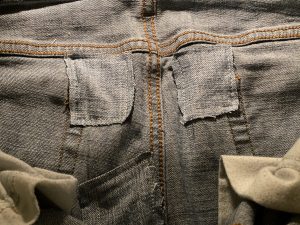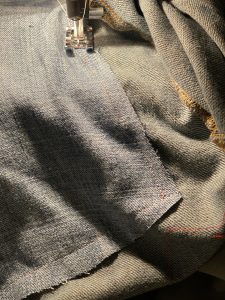In this tutorial, I will show you how to fix a pair of jeans by sewing on a patch.

Let’s face it, crotch blowout is very real, not to mention the torn corners your back pockets get from all that wallet friction. But unless you’re cool with pre-worn-in denim, which is to be honest rarely done well, your rate of success at wearing-in your jeans is dangerously close to your rate of destroying certain parts of them. There are two ways to deal with this. You can seek the professional help of a tailor or specialty denim repair service. Or, if you can’t wait and don’t want to pay, you can repair those rips, holes, and tears yourself. With a little knowledge, patching your own jeans isn’t all that tough and can be pretty satisfying. Here’s a detailed description of how it works.

(This post may contain affiliate links which means I make a small commission at no extra cost to you.)
What You’ll Need:
- Thread that matches your jeans (I usually use cream, unless there are 5 or more holes to patch, then I use red thread indicating that this is the last straw for these pants, time to buy a new pair!)
- Pins or Clips
- Sewing scissors
- Swatch of spare denim
- A sewing machine that can go forward and backward

The Video Tutorial:
Clean Up the Affected Area:
Use your scissors to cut off any fraying threads and trim around the edges of the hole (this will help you get a smooth transition from jeans to patch).
Turn Your Jeans Inside Out:
If you are patching your jeans with scrap denim, you should apply the patch from the inside.
Size Your Patch:
Cut the patch to size. It should overlap the edges of the hole by at least a quarter of an inch. If the denim around the hole is weakened, cover that area with the patch as well. Otherwise, you could have a new hole in a very short order.
Stitch It, Over and Over Again: Stitch over the edges in a zig-zag fashion several times, overlapping your previous stitches (this will prevent the thread from pulling out). Make sure you sew in alternating directions as you overlap. Do this at least three times over. Some experts darn the entire patch, meaning they cover the whole thing in stitches.
Trim the Edges:
Trim any loose fabric or threads and you’re good to go.
View comments
+ Leave a comment